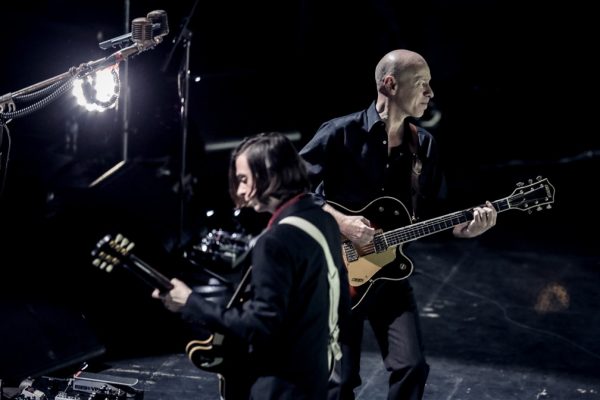Rock Concert Review: The The — Deconstructed
In every meaningful way, The The’s return to the States, the band’s first tour in 16 years, was generous.

The The in action on tour. Photo: courtesy of the artist.
By Clea Simon
For his first tour in 16 years, The The’s Matt Johnson promised a more stripped-down version of his lush trademark sound. “I’m now a very different person to the one who wrote and recorded these songs,” he said in his tour notes. However, the five-piece lineup Johnson led at the Orpheum on Friday – The The has long been Johnson working with various sidemen – was anything but spare, with bass, guitar, keyboards, and Earl Harvin’s wildly expressive percussion given free rein. What had been cleared away was Johnson’s rich romanticism, the sweet synth pop of the band’s ‘80s and ‘90s heyday that propelled both Johnson’s most biting social commentaries as well as more personal outpouring of love and lust. The result revealed the bones of his work: from the blues to the music hall, the Velvets to Muscle Shoals. Call it The The deconstructed.
In every meaningful way, the The’s return to the States was generous. Lasting nearly two hours, the show covered the band’s two-decade career, from ‘80s hits like “Infected” and “This is the Day” to later deep cuts, like “Love is Stronger than Death” (from 1993’s Dusk) The show opened with “Global Eyes,” from The The’s last full album, 2000’s NakedSelf, to an appropriately stark set, the band silhouetted against a white background. Johnson himself was conversational, providing bits of history (explaining, for example, that “Soul Catcher” was inspired by a visit with his then-young son to a museum) without being pandering. And if some of his more lustful songs might have been relics of youth, the biting social commentary was still apropos. While he invited the audience to sing along with the hits – many in the near-capacity theater appeared to know the lyrics to every song – he sang too.
Like the sketches and album artwork and clips of old videos that replaced the blank backdrop as the set progressed, the arrangements further invited listeners into the process. The heavy reverb of guitarist Barrie Cadogan in “We Can’t Stop What’s Coming,” for example, revealed the swampy American roots of Johnson’s blue-eyed soul, while D.C. Collard’s organ intro to “Beyond Love” referenced gospel. (The band consisted primarily of veterans of Johnson’s three previous tours: Collard, Harvin, and bassist James Eller, along with guitarist Cadogan.) Shorn of its dance club electronics, “Infected” came across as punk funk, in the vein of the Bush Tetras, while “This is the Night” melded the almost sing-song cadence of British music hall with its rock roots. None of this was a surprise: Johnson has always paid homage to his sources, from the “Ballroom Blitz” quote opening “Armageddon Days” to Hank Williams, whose “I Saw the Light” he covered at the Orpheum. What was a revelation was seeing how these threads came together – the Velvets drone Cadogan laid under “Bugle Boy,” or example, or the Creedence-style distortion in “Soul Catcher.”
What held constant throughout was Johnson’s emotive baritone, seemingly unchanged by age. Warm and welcoming, it provided the through note – the recognizable soul of the band. As images of Thatcher-era riots flashed on screen, Johnson’s instrument, as much as those scenes of a world gone awry, brought us full circle once again, with a soundtrack to match.
A former journalist, Clea Simon is the author of three nonfiction books and 25 mysteries. A contributor to such publications as the Boston Globe, New York Times, and San Francisco Chronicle, she lives in Somerville with her husband, Jon Garelick. She can be reached here and on @Clea_Simon.
